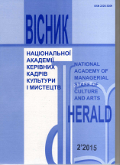ВЕРИСТСКАЯ ИДЕЯ ЖЕНСКИХ ОБРАЗОВ В СОВРЕМЕННОЙ КИТАЙСКОЙ ОПЕРЕ И ОПЕРАХ ДЖ. ПУЧЧИНИ
Veristical idea of female characters in modern Chinese opera and opera G. Puccini
Author(s): Bin FengSubject(s): Theatre, Dance, Performing Arts, Music, Cultural Anthropology / Ethnology
Published by: Національна академія керівних кадрів культури і мистецтв
Keywords: tradition; musical theater; opera; Verismo; female character; opera character
Summary/Abstract: The article deals with the specifics of the art of female characters in modern Chinese opera and opera G. Puccini. By comparing the image of Jiang Jie from the opera Yan Ming and images of Cio-Cio-San and Liu of "Madama But-terfly" and "Turandot" G. Puccini reveals their veristical complex and differences in the principles of musical incarnation.The purpose of the article – to identify verist artistical complex ideas of female characters in Chinese opera and contemporary operas G. Puccini by comparing the image of Jiang Jie from the opera Yan Ming and images of Cio-Cio-San and Liu from the opera "Turandot" and "Madama Butterfly" and to determine the differences in the principles of their musical incarnations.Chinese musical theater has its own rich national traditions that from the middle of the twentieth century come into a creative dialogue with the European opera. This interaction is reflected in the formation of specific types of female characters in Chinese opera, which by their artistic idea largely overlap with the European verismo.A typical example of such a cross-cultural intersections are heroic female characters of Chinese opera 1950-60-ies., Including the image of Jiang Jie from the Yang Ming`s opera.For the contemporary singer-performer in terms of cultural integration between China and Europe, becoming particu-larly urgent task of differentiating "native" and "foreign" musical style, content-awareness of the semantic content of a musical-stage image. These factors largely determine the logic of performing and interpreting arsenal performing funds.Comparison of the female characters in the opera "Sister Jiang", "Turandot" and "Madama Butterfly" allow to draw conclusions about the similarities and differences of modern Chinese opera and opera Puccini. The similarity is primarily an ethical pathos central female characters of these operas, in the idea of self-denial and self-sacrifice as a moral norm personality. Similarly is veristical complex of moral responsibility of hero for his actions and subject compliance with veristical "bloody drama".The differences can be noted in the beginning of the gradations of heroic female characters, expressed in the "objective" or "subjective" tone of their actions. If Sister Jiang sacrifices his life in the name of civic ideals, her story is frankly heroic character, the heroine operas G. Puccini act in a different semantic context, in the space of personal rela-tionships. Their conscious decision to sacrifice their lives due to the renunciation of his own selfishness, and correlated with the idea of forgiving love.Also, differences are evident in the principles of musical and artistic expression – the predominance of the psy-chological development of images from G. Puccini, and accordingly, the detail of musical expression vocals. More objec-tive approach in Chinese opera, which is realized through the use of folk thematic and lack of psychological nuances in the music characteristic.
Journal: Вісник Національної академії керівних кадрів культури і мистецтв
- Issue Year: 2015
- Issue No: 2
- Page Range: 163-167
- Page Count: 5
- Language: Russian

